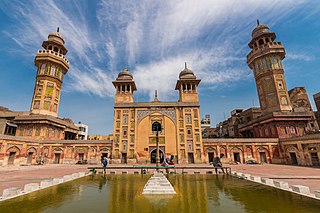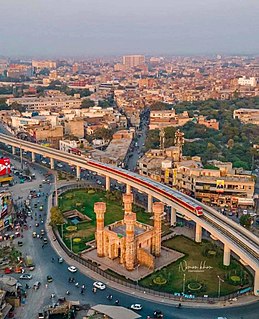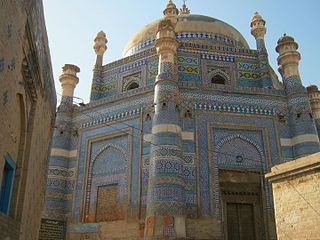
A World Heritage Site is a landmark or area with legal protection by an international convention administered by the United Nations Educational, Scientific and Cultural Organization (UNESCO). World Heritage Sites are designated by UNESCO for having cultural, historical, scientific or other form of significance. The sites are judged to contain "cultural and natural heritage around the world considered to be of outstanding value to humanity".

The Lahore Fort is a citadel in the city of Lahore, Pakistan. The fortress is located at the northern end of walled city Lahore, and spreads over an area greater than 20 hectares. It contains 21 notable monuments, some of which date to the era of Emperor Akbar. The Lahore Fort is notable for having been almost entirely rebuilt in the 17th century, when the Mughal Empire was at the height of its splendour and opulence.

The Wazir Khan Mosque is a 17th-century mosque located in the city of Lahore, capital of the Pakistani province of Punjab. The mosque was commissioned during the reign of the Mughal Emperor Shah Jahan as a part of an ensemble of buildings that also included the nearby Shahi Hammam baths. Construction of Wazir Khan Mosque began in 1634 C.E., and was completed in 1641. It is on the UNESCO World Heritage Tentative List.
There are over 2500 listed buildings in Liverpool, England. A listed building is one considered to be of special architectural, historical or cultural significance, which is protected from being demolished, extended or altered, unless special permission is granted by the relevant planning authorities.

Chauburji is a Mughal era monument in the city of Lahore, capital of the Pakistani province of Punjab. The monument was built in 1646 C.E. during the reign of the emperor Shah Jahan. It previously acted as a gateway to a large garden.

In Pakistan, tourism is a growing industry. In 2010, Lonely Planet termed Pakistan "tourism's 'next big thing' for more years than we care to remember". The country is geographically and ethnically diverse, and has a number of historical and cultural heritage sites. The upsurge in tourism in the past few years has been aided by the Government of Pakistan's recent decision to end mandatory No Objection Certificates for foreign tourists seeking to visit certain parts of the country.
Pakistani architecture is intertwined with the architecture of the broader Indian subcontinent. With the beginning of the Indus civilization around the middle of the 3rd millennium BC, for the first time in the area which encompasses today's Pakistan an advanced urban culture developed with large structural facilities, some of which survive to this day. This was followed by the Gandhara style of Buddhist architecture that borrowed elements from Ancient Greece. These remnants are visible in the Gandhara capital of Taxila.
Pakistan's cultural heritage includes archaeological sites, stupas, forts, shrines, tombs, buildings, residences, monuments, and places of worship. Until the passing of the Eighteenth Amendment to the Constitution of Pakistan, some sites were under the federal government while others were in the provincial domain.

Cultural properties of Indonesia are those items defined by Indonesian law as of "important value for history, science, and culture", and include both man-made artefacts and natural objects. The cultural properties number more than 8,000 and include ancient Hindu and Buddhist temples, mosques, historic colonial buildings, forts, art galleries, national parks and beaches. A number of the sites are World Heritage Sites.

The Javed Manzil or the Allama Iqbal Museum is a monument and museum in Lahore, Pakistan. Muhammad Iqbal lived there for three years, and died there. It was listed as a Tentative UNESCO site, and was protected under the Punjab Antiquities Act of 1975, and declared a Pakistani national monument in 1977. In honour of Iqbal, a Pakistani national poet, it was converted into a museum, inaugurated in December 1984.

The Tomb of Dai Anga, also known as the Gulabi Bagh, is a 17th-century Mughal tomb complex located in the Mughal-era suburb of Begampura, outside the Walled City of Lahore, Pakistan.

Buddhu's Tomb, also known as Buddhu kā Āwā, is a 17th-century tomb located in Lahore, Pakistan. The tomb is traditionally attributed to that of a Lahore resident named Buddhu, though research suggests the tomb was actually built for the wife of Khan-e-Dauran Bahadur Nusrat Jang. Some Sikhs regard the tomb to be a gurdwara built by Buddhu.

Tomb of Tahir Khan Nahar is situated at Seet pur, Muzaffargarh, Pakistan. This tomb is protected by the Federal Government of Pakistan. The tomb of Tahir Khan Nahar situated in central Sitpur (Seetpur), a town in southern Punjab near the confluence of the Indus River and Chenab River. Tahir Khan Nahar built the present tomb and mosque at seetpur in his lifetime, at the close of fifteenth century A.D. The tomb of Tahir Khan Nahar bears very close resemblance with the Tomb of Shah Rukn-e-Alam at Multan that was built around 1320.













